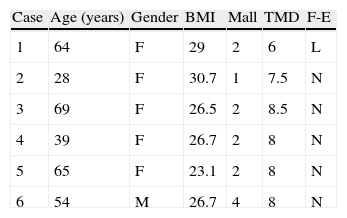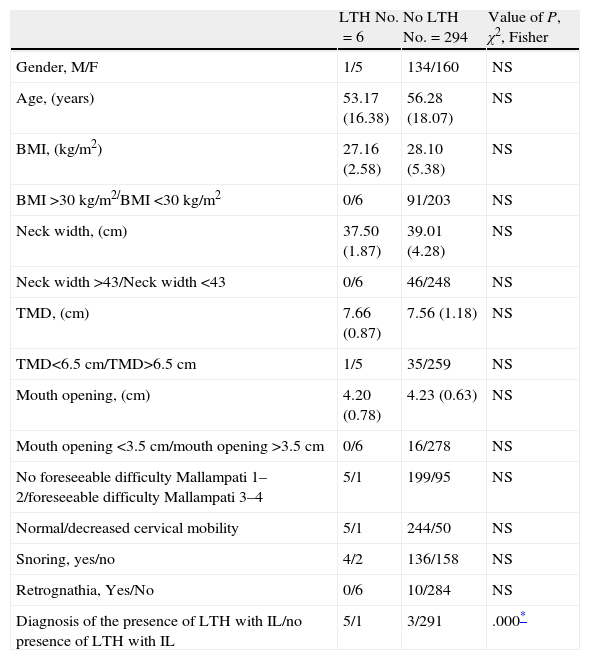Prevalence of the lingual tonsillar hypertrophy is unknown but it is believed that its presence is associated with the difficult airway. To investigate this, indirect laryngoscopy was performed on patients in the preoperative evaluation and this pathology was diagnosed. The relationship with difficulty of viewing the larynx, intubation and ventilation, under general anaesthesia and using direct laryngoscopy, was then studied.
MethodsWe performed the demographic variable checks and tests for predicting difficult intubation (mouth opening, thyromental distance, cervical flexion-extension, neck thickness, and Mallampati test), in the preoperative step on 300 patients who were going to be submitted to general anaesthesia. We then performed indirect laryngoscopy on them using a 70° rigid laryngoscope to ascertain the frequency of appearance of lingual tonsillar hypertrophy. Next, under general anaesthesia, we carried out direct laryngoscopy to verify whether there was difficulty in viewing the larynx and intubation and ventilation. We then investigated the association of demographic predictors of difficult intubation, including indirect laryngoscopy, with the presence of this condition.
ResultsPrevalence of lingual tonsillar hypertrophy was 2%. No relationship between the appearance of this entity and the difficulty of viewing the larynx, intubation and ventilation was found. Only indirect laryngoscopy was linked to the appearance of this pathology.
ConclusionsLingual tonsillar hypertrophy is a relatively frequent disorder, whose presence is not usually associated with difficult airway.
Se desconoce la prevalencia de la amígdala lingual hipertrófica, pero se cree que su presencia está asociada con la vía aérea difícil. Para investigarlo se realizó a los pacientes una laringoscopia indirecta en el preoperatorio y se diagnosticó esta enfermedad. Después, bajo anestesia general y laringoscopia directa estudiamos su relación con la dificultad de visión de la laringe, intubación y ventilación.
MétodosA 300 pacientes que iban a ser sometidos a anestesia general, además de realizarles en el preoperatorio los predictores demográficos y de vía aérea difícil (prueba de Mallampati, apertura bucal, distancia tiromentoniana, flexoextensión cervical y grosor del cuello), se les practicó una laringoscopia indirecta con el laringoscopio rígido de 70° y se comprobó la frecuencia de aparición de la amígdala lingual hipertrófica. Después, bajo anestesia general y laringoscopia directa verificamos si existía dificultad de visión e intubación de la laringe y de ventilación. Exploramos la relación de las 3 variables anteriores con esta enfermedad mediante la prueba de Fisher. También, se investigó la asociación de predictores demográficos y de vía aérea difícil incluyendo la laringoscopia indirecta, con la presencia de esta afección.
ResultadosLa prevalencia de amígdala lingual hipertrófica fue del 2%. No se encontró relación entre la aparición de esta entidad y la dificultad de visión de la laringe, intubación y ventilación. Solo la laringoscopia indirecta previno la aparición de esta enfermedad.
ConclusionesLa amígdala lingual hipertrófica es una entidad relativamente frecuente. Su presencia no se asocia habitualmente con la vía aérea difícil.










